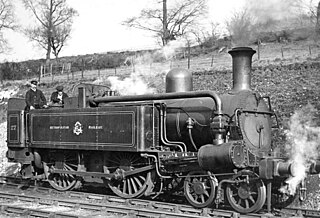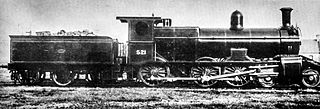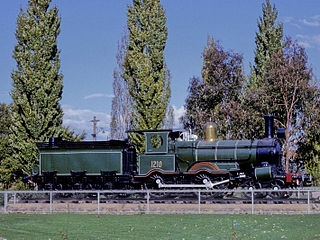| New South Wales Z19 class | |||||||||||||||||||||||||||||
|---|---|---|---|---|---|---|---|---|---|---|---|---|---|---|---|---|---|---|---|---|---|---|---|---|---|---|---|---|---|
 Class Z19 Locomotive in service | |||||||||||||||||||||||||||||
| |||||||||||||||||||||||||||||
| |||||||||||||||||||||||||||||
| |||||||||||||||||||||||||||||
| |||||||||||||||||||||||||||||
The Z19 class (formally A.93 class) was a class of steam locomotive built for and operated by the New South Wales Government Railways of Australia. [1]
| New South Wales Z19 class | |||||||||||||||||||||||||||||
|---|---|---|---|---|---|---|---|---|---|---|---|---|---|---|---|---|---|---|---|---|---|---|---|---|---|---|---|---|---|
 Class Z19 Locomotive in service | |||||||||||||||||||||||||||||
| |||||||||||||||||||||||||||||
| |||||||||||||||||||||||||||||
| |||||||||||||||||||||||||||||
| |||||||||||||||||||||||||||||
The Z19 class (formally A.93 class) was a class of steam locomotive built for and operated by the New South Wales Government Railways of Australia. [1]

By 1877 the main lines in New South Wales were nearing Tamworth, Wagga Wagga and Orange. The additional distances required an increase in motive power, especially as at that time, locomotives were changed after quite short journeys. They were only in service when manned by their regular crew. [2]
Between 1877 and 1881, the initial order of 50 of these 0-6-0 wheel arrangement locomotives were delivered from Beyer, Peacock and Company. Between 1880 and 1891, Beyer, Peacock delivered a further nine and local manufacturer, Henry Vale and Company eighteen. [2] [3]
The load which these locomotives could haul over the Blue Mountains line was 128 tonnes at 11–13 km/h. William Thow, the then Locomotive Engineer of the South Australian Railways, was commissioned by the New South Wales Government in 1888 to enquire into the New South Wales Government Railways locomotives and rolling stock. [4] He recommended modifications to this class as he considered them to be the best designed and proportioned of the locomotives then in service. This included Belpaire boilers and new cabs. [3]
Following the reclassification of locomotives in 1891, three additional similar locomotives were added to the class. With the arrival of the T class saw the class relegated to secondary roles and coal services in Newcastle. Between April 1902 and February 1910, fourteen were converted to 20 class 2-6-4 tank engines at Eveleigh Railway Workshops. By 1933 many had been withdrawn, with only 36 remaining in service. [5]
Having a short wheelbase and no leading bogie, the locomotives had a tendency to derail and they were ultimately restricted to a maximum speed of 40 km/h and relegated to shunting and branch line traffic. Driven slowly, they could negotiate the most appalling curves and badly maintained or unballasted tracks. They were therefore ideal in goods yards, such as Darling Harbour and Port Waratah with the last two withdrawn from the latter in August 1972. Branch lines such as those to Dorrigo, Batlow and Oberon where grades of up to 1 in 25 (4%) and curves as sharp as 100.6 m (5 chains) radius could be encountered were ideal for this class and these were the only locomotives permitted on these lines until dieselisation. [3] [5]
Four locomotives of the class have been preserved:
| Preserved Z19 Class Locomotives | ||||||||
|---|---|---|---|---|---|---|---|---|
| No. | Description | Manufacturer | Year | Current Organisation | Location | Status | Ref | |
| 1904 | 0-6-0 Goods | Beyer, Peacock and Company | 1877 | Dorrigo Steam Railway and Museum | Dorrigo | stored | Porthole cab | |
| 1905 | 0-6-0 Goods | Beyer, Peacock and Company | 1877 | Transport Heritage NSW | Thirlmere | static exhibit | NSW Locomotive, Steam 1905 | |
| 1919 | 0-6-0 Goods | Beyer, Peacock and Company | 1878 | Glenreagh Mountain Railway | Glenreagh | stored | Steam Locomotive 1919 | |
| 1923 | 0-6-0 Goods | Beyer, Peacock and Company | 1879 | Dorrigo Steam Railway and Museum | Dorrigo | stored | Cutaway cab | |

A Garratt is a type of steam locomotive invented by British engineer Herbert William Garratt that is articulated into three parts. Its boiler, firebox and cab are mounted on a centre frame or "bridge". The two other parts, one at each end, have a pivot to support the central frame; they consist of a steam engine unit – with driving wheels, trailing wheels, valve gear and cylinders – and, above it, fuel and/or water storage.

Under the Whyte notation for the classification of steam locomotives, 2-6-0 represents the wheel arrangement of two leading wheels on one axle, usually in a leading truck, six powered and coupled driving wheels on three axles and no trailing wheels. This arrangement is commonly called a Mogul.
Beyer, Peacock and Company was an English railway locomotive manufacturer with a factory in Openshaw, Manchester. Founded by Charles Beyer, Richard Peacock and Henry Robertson, it traded from 1854 until 1966. The company exported locomotives, and machine tools to service them, throughout the world.

Under the Whyte notation for the classification of steam locomotives, 0-6-4 represents the wheel arrangement of no leading wheels, six powered and coupled driving wheels on three axles, and four trailing wheels on two axles.

The Metropolitan Railway A Class and B Class were 4-4-0T condensing steam locomotives built for the Metropolitan Railway by Beyer Peacock, first used in 1864. A total of 40 A Class and 26 of the slightly different B Class were delivered by 1885. Used underground, the locomotives condensed their steam, and coke or smokeless coal was burnt to reduce the smoke.
Under the Whyte notation for the classification of steam locomotives by wheel arrangement, a 4-8-2+2-8-4 is a Garratt articulated locomotive consisting of a pair of 4-8-2 engine units back to back, with the boiler and cab suspended between them. The 4-8-2 wheel arrangement has four leading wheels on two axles, usually in a leading bogie, eight powered and coupled driving wheels on four axles and two trailing wheels on one axle, usually in a trailing truck. Since the 4-8-2 type is generally known as a Mountain, the corresponding Garratt type is usually known as a Double Mountain.

The Z12 class was a class of 4-4-0 steam locomotives built for and operated by the New South Wales Government Railways of Australia.

The 17 class was a class of steam locomotive built by the Vulcan Foundry for the New South Wales Government Railways of Australia.

The C30 class was a class of steam locomotives built by Beyer, Peacock and Company and Eveleigh Railway Workshops for the New South Wales Government Railways of Australia.

The Z20 class is a class of steam locomotive built for and operated by the New South Wales Government Railways of Australia.

The C32 class was a class of steam locomotives built for the New South Wales Government Railways of Australia.

The C34 class was a class of steam locomotives built by Eveleigh Railway Workshops for the New South Wales Government Railways of Australia.

The AD60 class were Beyer-Garratt patent articulated four-cylinder, simple, non-condensing, coal-fired superheated, 4-8-4+4-8-4 heavy goods steam locomotives built by Beyer, Peacock and Company for the New South Wales Government Railways in Australia.

The Z25 class was a class of 2-6-0 wheel arrangement steam locomotives built by Beyer, Peacock & Co. for the New South Wales Government Railways of Australia.

The South African Railways Class NG G162-6-2+2-6-2 of 1937 is a narrow gauge steam locomotive.
Hunter Valley Mining Locomotives (Australia) included the South Maitland Railways 10 Class which were ordered by SMR and built by Beyer Peacock. Beyer Peacock suggested a tank engine as it would be ready earlier and could go fast backwards as opposed to a tender engine which could not. They arrived between 1912 and 1925 with a total of 14 engines produced. These served alongside Richmond Vale Railway's ROD 2-8-0s and Kitsons, and New South Wales Government Railways locomotives. Also made by Beyer Peacock was the SMR 15 class which was a copy of the NSWGR 30 Class. Numbers 15 and 16 were built in 1912 and No 29 in 1923. These were initially used for passenger services but when that stopped they pulled coal for the rest of their lives. All were scrapped in late 1973. The Kitson locomotives were known on the Richmond Vale Railway as the 9-11 Class. Locomotives 9,10 and 11 were tank locomotives and had the appearance of a side tank version of an ROD 2-8-0. Numbers 9 and 10 ended their careers on the RVR's Hexham washery shunt and the short trip to Stockrington Colliery. No 9 was originally called Pelaw Main and 10 was called Richmond Main. No 11 was called Hexham. The ROD 2-8-0 Locomotives mentioned above were purchased by J&A Brown for Coal Haulage on their Richmond Vale Railway, 13 ROD Locomotives were purchased in all, three remain.

The Z11 class was a class of steam locomotives built for the New South Wales Government Railways in Australia.

The F351 class was a class of steam locomotives built for the New South Wales Government Railways in Australia.

1210 is a two-cylinder, simple, non-condensing, saturated, coal-fired ‘8 wheeler’ type, 4-4-0 steam locomotive built for the New South Wales Government Railways in 1878 by Beyer, Peacock and Company. It is part of the Z12 class of locomotives

The Steam tram motors were built for and operated by the New South Wales Government Tramways of Australia.

| Wikimedia Commons has media related to New South Wales Z19 class locomotives . |